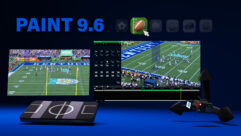Highlighting the Word
Jan 1, 1999 12:00 PM,
Peter H. Putnam
One of the fastest-growing markets for large-screen displays is in housesof worship. Churches of all types and sizes are installing projectors,monitors, and even videowalls for image magnification (IMAG) and thedisplay of lyrics and music to hymns. The increasing demand for largeelectronic images is a natural result of larger sanctuaries that hold asmany people as a live theater, and the conduct of services may require oneor more video cameras just so members of the congregation in the back rowcan see who is at the lectern.
Unlike a movie theater or playhouse, church environments are somewhathostile to projection technology. Soaring atriums and the lack of columnsmay be great for sightlines, but they make it difficult to fly a projectionsystem without a lot of tricky rigging. Because the ministers may be somedistance from viewers, bright lighting is mandated, perfect for video but amajor headache for projection screens.
What kinds of projection systems work well in churches? How much brightnessis required, and what resolutions are the most practical? When does avideowall make more sense than a straight projection system? What aboutwide viewing angles? These are all legitimate questions.
See the lightThe biggest single obstacle to projection systems of any kind is theambient lighting environment found in existing churches. They are designedto allow natural daylight to stream in through clear windows, texturedglass or stained glass. Interior lighting will supplement daylight,although it is usually much warmer in color.
Throwing a projection system into this mix requires a considerable amountof lumens to establish the high (white) end of a grayscale image. If a 750lumen projector will produce a bright enough image on a 69x 89 (1.8 m x 2.4m) screen using a 20 foot (6.1 m) projection throw, the inverse square lawtells us that a 3,000 lumen projector is required to generate the samebrightness at double that distance.
Assume we are in a rather large church and want to use a larger projectionscreen. We can increase the image size by 50%-from 8 feet (2.4 m) to 12feet (3.7 m) with a 1.5:1 zoom lens, but doing so will throttle back on thelight output by 50%. The projector needs to crank out 6,000 lumens tomaintain equivalent image brightness.
Increasing the throw again by 50% to 60 feet (18.3 m) doubles thebrightness requirement again, now requiring 12,000 lumens. Using awide-aperture lens is usually cost effective; one full f/stop will beneeded to maintain the same brightness with the 50% larger image, bringingus back down to 6,000 lumens. We can further improve image quality bylowering room lights and making sure little or no ambient light spills onthe screen.
The First Baptist Church of West Palm Beach, FL, is shaped like a longrectangle with ceilings rising to 30 feet (9.1 m) above the congregation.Cathedral floor-to-ceiling windows on both sides are equipped withmotorized shades, although the preference is not to use them. MediaVisions, Birmingham, AL, overcame the high ambient light problem byinstalling a lightvalve projector with a 5:1 prime lens, filling a 99x129screen at 65 feet (19.8 m) for IMAG and graphics.
Great Hills Baptist Church, Austin, TX, has 3,400 seats. Media directorCollin Lambert recently purchased a pair of SVGA projectors for IMAG andgraphics projection from Fowler, Norman, OK. Fowler installed a pair of12.59×169 (3.8 m x 4.9 m) motorized front screens offset by 20 feet (6.1 m)either side of the pulpit for wider viewing angles. The projection throw is88 feet (26.8 m), but 5,000 lumens per screen is bright enough under theplentiful video lighting.
If the budget can stand it, stacking projectors is a more reasonable way toachieve more brightness, taking care to match lenses and white balanceadjustments. If 3,000 lumens is not enough, adding another projector willdouble the light output, allowing for a 50% increase in either image sizeor projection throw. Of course, this means an increase in rigging, powerand the square area available for stacking the projectors. Fan noise andheat generation will also double.
Front projection can be a bear in churches. It would appear that 2,000 to4,000 lumens would suffice for medium sanctuaries with larger churchesstacking projectors to achieve 5,000, 8,000 and even 10,000 lumens. Untilrecently, there was not a big selection of high-horsepower models, but youwill see more at INFOCOMM ’99, including some 2,000+ lumen boardroom boxesideal for smaller installations and stacking applications.
Behind the scenesWhat if there’s just no place available to fly or support afront-projection system? Investigate a rear-projection setup. Using thatsame 12 foot (3.7 m) screen and a 1.5:1 lens, all we need is an 18 foot(5.5 m) projection throw, but with some short lenses, a throw of only 10feet may be required. As few as 2,000 lumens may do the job, and either asmaller projector or double-stack can be installed with less rigging andsmaller space requirements.
There are a couple of catches, such as the amount of space over the pulpit.There may not be enough depth for rear projection, or there may be a tallbackdrop that will get in the way. A tougher problem will be stained-glassor decorative windows, which often run from floor to ceiling and also spilla lot of light onto a rear-projection screen. Flying a screen over can beproblematic because of aesthetics.
For these reasons, rear-projection screens are often built into walls toeither side of the pulpit, high enough to clear a choir standing on severallevels of risers. This is about the only practical way to achieverear-projection and maintain an elegant look. Enclosed rear screens arealso protected against stray ambient light.
Another catch is that IMAG setups require lots of stage lighting, and it islikely most of that lighting will come in the form of a stage wash. We haveto crank up the lumens again to avoid washing out the screen. Unless thelighting instruments can be refocused, the order of magnitude could beeasily two or three times the brightness needed under dimmed room lights.
Media Visions provided a solid rear-projection solution to the FirstBaptist Church of Muscle Shoals, AL, by stacking a pair of projectors withx1.5 to x3 zooms on a 139×179 (4 m x 5.2 m) screen. Light output issomewhere between 7,000 and 8,000 lumens in high-output mode, and they needevery bit of it to make video IMAG and PowerPoint graphics stand outagainst a full stage wash of video lighting. Mike Cruce of Media Visionseven built a custom bezel around the screen, giving the appearance of ahuge television.
Looking insideIn the past year, a new approach has been taken to solve imageproblems-videowalls. They can be flown or installed anywhere, are largelyimmune to ambient light and provide more than enough brightness. Although avideowall is a more mechanically complex and a heavier installation, itanswers all three problems at once.
What makes videowall technology even more attractive is the availability ofboth LCD and DLP imaging engines. These projection cubes offer a brighterimage than possible with conventional 7 inch (178 mm) CRT projectionengines with half the weight and 25% more vertical resolution. This meansthat a 3×3 cube of 640×480 CRT cubes weighing more than half a ton (450 kg)can be replaced with a 3×3 848×600 wall that tips the scales around 600pounds (270 kg).
In some congregations, the population has increased so much that crowdsoverflow the sanctuary and often watch the services from large-screendisplays in vestibules, or even separate rooms. The Times Square Church,New York, uses seven projection cube and monitor walls for IMAG, both inthe church and in separate viewing rooms. GVC, Quakertown, PA, designed andinstalled each of the walls.
The 2,000-member Grace Presbyterian Church, Peoria, IL, also opted for a4x4 CRT projection cube system designed and installed by Innovative DesignTechnologies, Burbank, CA. The system is used for displaying everythingfrom IMAG video and graphics to live satellite feeds and other broadcastmaterial. This 160 inch (4 m) diagonal display sits center stage, directlybehind the pulpit.
Even plasma monitors will get into the act. One company demonstrated avideowall of 40 inch (1 m) 640×480 plasma monitors at NAB and INFO-COMM.Currently, the mullions between each screen are quite large, but it may bepossible to cut them in half and achieve individual cube weights of around70 pounds (32 kg). The form factor will get smaller, too; with brackets,the depth should not be much more than a foot (305 mm).
Plasma monitors do not have quite the light output of a CRT, LCD or DLPrear-projection system. In tests I conducted this past year, the bestgray-scale images yielded approximately 9 foot-lamberts to 11 foot-lamberts(0.003 candles/cm[superscript]2 to 0.004 candles/cm[superscript]2) at thescreen surface, which is less than half of what a well-tuned DLP projectioncube can produce. Resolution of 40 inch models is currently at 640×480(4:3) or 852×480 (16:9), great for video and VGA graphics but tricky withanything higher without a high-quality scan converter.
Resolution and image sizeAlthough the resolution of large-screen display systems jumps another levelwith each passing year, it may not be necessary for you to sit on thesidelines. If you use a projector or monitor to show video most of thetime, then existing SVGA high-brightness imaging engines will work justfine. As cutting-edge XGA and SXGA display devices are brought to market,the price of older SVGA, LCD and DLP projection systems will come downquite a bit in price.
Some congregations project lyrics from hymns in addition to live video.Conventional character generators are probably sufficient to accomplishthis, although the titles could be scan-converted from higher-resolutioncomputer displays. It is also possible to display graphics to enhance asermon or gospel or captioning for congregants with hearing disabilities.
What image resolution is minimally required for video projection in achurch? For that answer, we need to address the size of the projectedimage. For 525-line video, the rule of thumb has been 7 feet (2.1 m) ofviewing distance for each foot (305 mm) of picture height. Less distancemeans the scan lines in the image will be apparent, while more distancemeans less image detail can be perceived.
Currently, the lowest resolution available in a lightvalve projectionsystem is line-doubled video, essentially 640×480. Although the pictureinformation is now displayed progressively, the scan line structure remainsthe same. If the rear seats in a given church were 60 feet (18.3 m) fromthe screen, the minimum screen height rule would indicate that the verticalimage measurement should be at least 8.5 feet (2.6 m). Rounding up, thistranslates into a 99×129 (2.7 m x 3.7 m) image.
Although everyone will be able to enjoy the big, bright images, video linestructure will be apparent to viewers in the first few rows. One possiblesolution would be to use a line tripler, quadrupler or video scalar toimprove resolution. For CRT-engined lightvalve projection systems,additional line multiplying would be a worthwhile investment.
For LCD- and DLP-engined lightvalves, the minimum screen resolution isgoing to be at least 800×600 and can go as high as 1,280×1,024. Assuming aquality scalar is used, optimum viewing distance will drop as low as x3 tox5 the screen height. There are plenty of LCD and DLP lightvalves operatingat this screen resolution. Line triplers can also be used with XGAprojection systems because they produce images with 720 to 730 active scanlines.
Everyone can watchNow that we have considered brightness and resolution, we need to addressthe issue of viewing angles. Assuming there are no major sightlineproblems, such as supporting beams or columns, viewing angles could be analmost unsolvable problem.
Newer churches tend to be designed with seating and stage plans thatresemble theaters. Typically, chevron-style or semi-circular theaterseating is employed, resulting in viewing angles that usually stay within atotal viewing angle cone of 120 degrees. For 75% of the congregation,viewing angles to a single screen will be within optimal limits.
Many churches use a fan design, not unlike that found in a theater. Thislayout usually results in a wide pulpit area with the seats in front of thechurch in the optimal viewing cone of 90 degrees or 45 degrees to eitherside of the optical center line.
Although congregants in the wing seats may have great views of the pulpit,they will be at a disadvantage when viewing projected IMAG and other video.Their seats often start at 40 degrees from the screen’s center line.Viewers at the far edges of these rows will often find themselves at anglesexceeding 60 degrees from center line, which is a tough problem for anyinstaller.
The wide viewing angles in these situations dictate the use of unity orlow-gain projection screens to disperse as much light energy as possiblefrom the projector. This dumps the burden of providing a bright image backon the projector and also mandates the careful use of broad and spotlighting to avoid washing out the screen.
Using gain screen surfaces will narrow the viewing angle and defeat thepurpose of projecting anything. Rear-projection systems are even morehamstrung when it comes to wide viewing angles, although they have come along way in dispersion technology. There is still a problem with hot spots,and viewing angles greater than 45 degrees off the center are just impractical. Incidentally, projection videowall cubes are subject to the sameconstraints as conventional rear-projection systems.
The answer is to use two identical displays, thereby creating multipleoptimal viewing angles. For example, positioning a pair of front- orrear-projection screens to either side of the pulpit at 30 degrees to theaudience’s center line now expands the total viewing angle to 75 degreeseither side of center. Even the cheap seats will fall nicely within thisexpanded cone. Although both screens will fall within a person’s field ofview, a viewer will likely stay focused on one display.
We still have to be careful with lighting, and we will have to install twocomplete projection or videowall systems with all of the attendant cabling,rigging and power requirements. Is the added expense worth it? This is adecision you will have to make with the powers that be. One good way to dothat is to set up two temporary screens and a couple of small projectors,letting everyone move about the seats to see the difference between asingle display and two displays.
HDTVIt is still a bit early in the game for churches to worry aboutimplementation, but there is plenty of interest. The wide expanse of apulpit and choirs is much better suited to HDTV than regular 4:3 video. Theproblem is that HDTV cameras and equipment are still too expensive for allbut the wealthiest congregations, and there is all that D/A conversionequipment that has to be installed. HDTV as a mainstream production anddisplay tool for religious services is probably six or more years off.
As I mentioned in my column in an earlier issue of S&VC, just about everyprojector and videowall available can scale HDTV to that device’s nativeresolution without much difficulty, provided the signal input is analog.Although several projectors are now including serial digital (D1) videoinputs, none are capable of decoding and reproducing 16:9 HDTV signals like720p or 1080i. It remains easier to use line tripling or quadrupling toimprove image quality and achieve more film-like video.
ConclusionsAs the church projection market grows, so do the number of productsavailable. Performance levels are also moving at an accelerated rate; itwas a big deal to get 2,000 lumens from a 200 pound (90 kg) projector onlythree years ago. Now, you will get that same light outputfrom a 35 pound(16 kg) chassis. Many manufacturers are shooting for 10,000 lumens in asingle-lens projector for 1999, and the prices of units in the 2,000 to5,000 lumen range continue to drop.
Regardless of which system you opt for, it is still a good idea to keep therules for screen size, viewing angles and lighting in mind. They are notlikely to change anytime soon.










